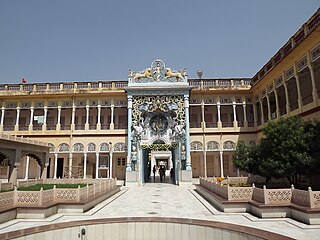
Rewa is a city in the north-eastern part of Madhya Pradesh state in India. It is the administrative center of Rewa District and Rewa Division. The city lies about 420 kilometres (261 mi) northeast of the state capital Bhopal and 230 kilometres (143 mi) north of the city of Jabalpur. The maximum length of Rewa district is 125 km from east to west and the length of Rewa from north to south is 96 km. This area is surrounded by Kaimur hills to the south Vindhyachal ranges pass through the middle of the district.

Jhunjhunu is a city in the state of Rajasthan in northern India and the administrative headquarters of Jhunjhunu District. Rajasthani and Hindi are widely spoken in Jhunjhunu. Jhunjhunu has given the highest number of soldiers to the Indian army and the paramilitary.

The Permanent Settlement, also known as the Permanent Settlement of Bengal, was an agreement between the East India Company and landlords of Bengal to fix revenues to be raised from land that had far-reaching consequences for both agricultural methods and productivity in the entire British Empire and the political realities of the Indian countryside. It was concluded in 1793 by the Company administration headed by Charles, Earl Cornwallis. It formed one part of a larger body of legislation, known as the Cornwallis Code. The Cornwallis Code of 1793 divided the East India Company's service personnel into three branches: revenue, judicial, and commercial. Revenues were collected by zamindars, native Indians who were treated as landowners. This division created an Indian landed class that supported British authority.
Pratapgarh, also called Belha or Bela Pratapgarh, is a town and municipality in the state of Uttar Pradesh in India. It is the administrative headquarters of Pratapgarh district, part of the Prayagraj division.

The Santhal rebellion, was a rebellion in present-day Jharkhand and West Bengal against the East India Company (EIC) and zamindari system by the Santhals. It started on June 30, 1855, and on November 10, 1855, martial law was proclaimed by the East India Company which lasted until January 3, 1856, when martial law was suspended and the rebellion was eventually suppressed by the presidency armies. The rebellion was led by the four sibling brothers - Sidhu, Kanhu, Chand, and Bhairav and their two sisters Phoolo and Jhano, who sacrificed their lives for the cause.
Alawalpur is a town and a municipal council in Jalandhar district in the state of Punjab, India. Alawalpur is named after Alawal Khan, a Pathan who ruled the area during the time of Maharajah Ranjit Singh. Sardar Himmat Singh Jallewalia, a Bains Jat Sardar, a general in Ranjit Singh's army, later conquered Alawalpur. His descendants still live in a fort located at the center of the city.
Hargaon is a town and a nagar panchayat in Sitapur district in the Indian state of Uttar Pradesh.
Konganapuram is a panchayat town in Salem district in the Indian state of Tamil Nadu.
Shankargarh is a town and a nagar panchayat in Prayagraj district in the Indian state of Uttar Pradesh.It Is Also Known As Kasauta Shankargarh.

Godaan is a famous Hindi novel by Munshi Premchand. It was first published in 1936 and is considered one of the greatest Hindi novels of modern Indian literature. Themed around the socio-economic deprivation as well as the exploitation of the village poor, the novel was the last complete novel of Premchand. It follows the story of an old poor farmer, stuck in a debt trap, who wants to purchase a cow, but is unable to do so because of lack of finances. It has been translated into English in 1957 by Jai Ratan and Purushottama Lal as The Gift of a Cow. A 1968 translation by Gordon C. Roadarmel is now considered "a classic in itself".
Gampalagudem is a town situated in the NTR district of Andhra Pradesh, India. It serves as the headquarters of the Gampalagudem mandal, which is under the administration of the Tiruvuru revenue division. The town is located on the banks of the Kattaleru river and is situated at a distance of 74 km (46 mi) from the district headquarters Vijayawada.

Prayagraj, also known as Ilahabad or Allahabad in an anglicized version in Roman script, and anciently Prayag, is a city situated on an inland peninsula, surrounded by the rivers Ganges and Yamuna on three sides, with only one side connected to the mainland Doab region, of which it is a part. This position is of importance in Hindu scriptures for it is situated at the confluence, known as Triveni Sangam, of the holy rivers. As per Rigveda the Sarasvati River was part of the three river confluence in ancient times. It is one of four sites of the Kumbh Mela, an important mass Hindu pilgrimage.

Prayagraj, also known as Allahabad or Ilahabad, is a metropolis in the Indian state of Uttar Pradesh. It is the administrative headquarters of the Prayagraj district, the most populous district in the state and 13th most populous district in India and the Prayagraj division. The city is the judicial capital of Uttar Pradesh with the Allahabad High Court being the highest judicial body in the state. As of 2011, Prayagraj is the seventh most populous city in the state, thirteenth in Northern India and thirty-sixth in India, with an estimated population of 1.53 million in the city. In 2011, it was ranked the world's 40th fastest-growing city. The city, in 2016, was also ranked the third most liveable urban agglomeration in the state and sixteenth in the country. Hindi is the most widely spoken language in the city.
Maulvi Liaquat Ali (1817-1892) was a Muslim religious leader from Allahabad (Prayagraj), in the state of Uttar Pradesh in present-day India. He was one of the leaders in the revolt against the British in 1857, in what is now known as the Indian Rebellion of 1857. As one of the most prominent leaders, Maulvi Liaqat Ali belonged to Village Mahgaon in Pargana Chail of District Prayagraj. He was a religious teacher, an upright pious Muslim, and a man of great courage and valour. His family traced their descent from the Jafri branch of Hashmis which had their offshoots at Jaunpur and other places. He was a humble and simple man but when he took the reins of the freedom struggle, he became a dreadful enemy of the British.
Numbardar or Lambardar was the village headman responsible for tax collection in the village during the British Raj. They were appointed under the Mahalwari system.
Manda was a zamindari, with lands located near Allahabad, Uttar Pradesh, in northern India.

Ghughudanga Zamindar Bari was the residential palace and place of business of the Ghughu-danga zamindar family. It is situated on the banks of the Purnobhoba River in Dinajpur District. The palace was destroyed by Pakistani soldiers in the 1971 Bangladesh Liberation War.

The Zamindars of Bengal were zamindars of the Bengal region of the Indian subcontinent. They governed an ancient system of land ownership.

Jhargram Raj was a zamindari which occupied a position in Bengal region of British India. The zamindari came into being during the later part of the 16th century when Man Singh of Amer was the Dewan/Subahdar of Bengal (1594–1606). Their territory was centered around present-day Jhargram district. Jhargram was never an independent territory since the chiefs of the family held it basically as the zamindars of the British Raj in India after Lord Cornwallis's Permanent Settlement of 1793. Although its owners were both rich and powerful, with the chiefs of the family holding the title of Raja, the Jhargram estate was not defined as a Princely State with freedom to decide its future course of action at the time of Indian independence in 1947. Later, the Vice-Roy of India agreed to recognize Jhargram as "Princely State" after the Second World War, but the proposal taken back as the British had decided to give independence to India.
The Revolt of Radharam, also known as the Chargola Uprising of 1786 or the Pratapgarh Rebellion, was an insurrection against the East India Company which took place in 1786. It was perpetrated by Radharam, the Zamindar of Chargola, in what is now the Indian state of Assam. The revolt was one of the earliest struggles against British authority in Northeast India.








